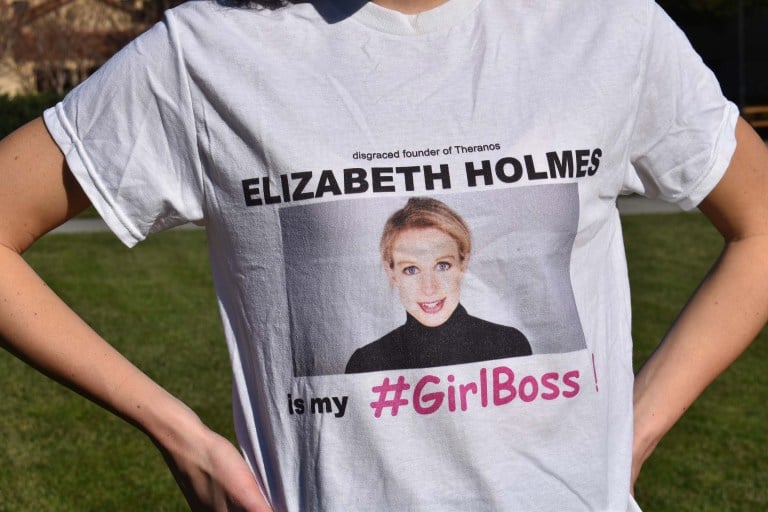the cultural power of
ELIZABETH HOLMES
The story of Elizabeth Holmes is playing out like a Greek tragedy, in which we’ve arrived at the third and final act. First, there was her rise from a 19-year-old Stanford dropout to the world’s youngest self-made female billionaire. Then, the scandal: a tidal wave of coverage, articles, documentaries, podcasts and books that sought to reveal what a scam both Holmes’s persona and Theranos’s operations had been all along.
Now, as the verdict finally arrives and Holmes faces sentencing on four counts of fraud, the cultural power of her name and image has taken on a very different form. Most trials with this degree of media attention happen twice: once in a criminal court, and then again in the court of public opinion. The latter decided long ago that Holmes is not only a criminal, but a joke.
There is a sizable swath of the internet dedicated to making fun of her, such as a TikTok community known as the “Holmies” who mock her with characteristic Gen-Z irony. There is merchandise. There are people who stood in line at the Santa Clara courthouse dressed up as the woman on trial. The story of Elizabeth Holmes, the Theranos founder, may be nearing its conclusion, but our cultural obsession with Elizabeth Holmes — Stanford’s very own blonde-haired, turtleneck-clad, deep-voiced, ruthlessly scamming Girlboss — is far from over.
INVENTING AN ICON
Between 2014 and 2015, Elizabeth Holmes appeared on the cover of seven major magazines, styled and posed in effectively the same way each time: black turtleneck, powerful gaze, blonde hair swept back. This highly curated personal image became as central to the story of Theranos as the actual function of the company itself. She cultivated a memorable cult of personality, which is often construed as at least part of what made Theranos so interesting to its ridiculously powerful board members and deep-pocketed investors.
Throughout the course of Theranos’s rise, heyday and eventual implosion, Holmes has been subject to the very tenuous marriage between our societal expectations for women in the public eye and tech leaders in the public eye. The Tech Bro archetype is lent credibility by his penchant for sweatpants and inability to self-present; at the same time, respectable media establishments have spent considerable energy debating Holmes’s split ends.
English professor Laura Goode has been writing about feminism and internet culture for much of her career. “In the way she has become a character in the text of her own media frenzy, there has been so much ink spilled both on her appearance and the shortcomings of her appearance,” Goode said of Holmes. She took care to point out the litany of privilege that Holmes leveraged to construct her public image: her whiteness, blondeness and inherent conventional beauty.
But Goode also noted how double-edged the media’s fixation on Holmes’s physical appearance has proven to be. Even at her peak — when Elizabeth Holmes was a press fixture, in a good way — intrigue about her self-presentation could slide very quickly into criticism of it. “I think that the cacophony — and the duality of both of those arguments — just highlights the no-win situation for all women in power, whether they’re corrupt or not,” Goode said.
Throughout her trial, the personal mythology of Elizabeth Holmes seemed to be inextricable from the Theranos scandal itself. The Wall Street Journal dedicated an entire piece on her courtroom wardrobe: She’s exchanged the black turtlenecks (with all their connotations of cutthroat power and genius) for pastel colors and diaper bags, reshaping her image to suggest domesticity and innocence — as if the difference between 20 years of freedom or imprisonment hinged on picking the right outfit.
CAPITALIZING ON THE JOKE
“I think that part of our cultural fascination, both with female scammers and with the fashion of female scammers, is that these stories call attention to the inherent scammery and illusion of fashion itself,” Goode told me. So many people wanted to dress up as Holmes for Halloween in 2019 that Bay Area retailers ran out of black turtlenecks.
Today, the media spectacle of the Theranos scandal has given rise to a miniature side industry of Holmes-themed merchandise, which you can buy on Amazon, Redbubble or Etsy. One former Theranos employee is selling her lab coat on Poshmark for $17,000. It’s a fair question to wonder to what degree the media’s treatment of Holmes’s fashion choices is an indication of just how gendered her press coverage has always been. Suffice to say, there was less of a manic rush to dress up as Theranos Chief Operating Officer Sunny Balwani for Halloween. Believe it or not, there were absolutely no articles written about what outfit Henry Kissinger wore to Theranos board meetings, and it’s much harder to find a T-shirt with Adam Neumann’s face on it.
In 2015, Holmes may have been earnestly admired as a kind of cultural icon, but in 2021 she was reduced to a punchline. One Etsy store, WeAreElizabethHolmes, is looking to capitalize on the joke. Most of their merchandise — pillows, face masks, mugs, tote bags, T-shirts — is done in the style of the popular streetwear brand OBEY: Holmes’s image rendered in black and white, with the word BOSS (or, affectionately, LIZZY) emblazoned in a red band at the bottom of the frame. Many of the products also include what might be the most famous line Holmes has ever spoken — “first they think you’re crazy, then they fight you, then you change the world” — which she delivered in an interview in 2015, spoken then, of course, in a deep, breathy baritone.
In her tote-bag likeness, Holmes’s face is reduced mostly to shadow, her eyes droopy and cartoonish and embarrassingly over-lined. Her hair is frizzy and badly splitting, even when rendered in a two-dimensional screen print. Her mouth is slightly open; her gaze is intense and askew, looking not at you but beyond you, fixated on some entrancing future horizon the rest of us can’t see. The resulting impression is not one of a rational, collected woman. You could call it a look of genius, if you’re feeling generous, but mostly the whole thing argues that the world never actually get past thinking of Holmes as crazy.
“We would say that we aren’t so much admiring of her, more amused that she was able to get so far on a lie,” one of the operators of WeAreElizabethHolmes, who runs the store anonymously for the sake of privacy, told me. They opened the online store a few months ago, initially as a hobby; they now ship merchandise all over the United States. The representative I spoke with estimated that roughly 70% of their sales so far have been to women. “As for her fan base, we think that it’s mostly young women who feel that they can identify with a female figure in the ‘brotopia’ of tech,” they said. “And the best part is, for most of the time, she won! Until she didn’t.”
The WeAreElizabethHolmes representative also noted that the image they were peddling was one that Elizabeth herself had gone to great lengths to construct. “She looks the part of the villain,” they said, seizing particularly on her blonde top knot and the Jobs-inspired black turtlenecks. What WeAreElizabethHolmes and other merchandisers have apparently figured out is that as much as there’s an audience for female success stories, there’s often a much bigger market for their downfalls.
“I found the shirt on Etsy, and I think it says, ‘Disgraced founder of Theranos Elizabeth Holmes is my hashtag Girlboss,’” Viva Donohoe ’25 told me. “And I bought it, because it’s fucking hilarious.” Contrary to the Etsy store representative’s assumptions, Donohoe is interested in the humanities and considers herself an ardent feminist. To her, the humor of the whole ordeal comes from how emblematic Holmes is of conventional feminism’s embrace of the Girlboss.
“I think it’s kind of like the whole reckoning that we’re having with the Girlboss archetype being really funny, and stupid, and not actually contributing to equality,” Donohoe said. “Especially like in feminist discourse, people are starting to realize: okay, it’s a disingenuous form of feminism. Women are now at the table, but they’re not changing the discussions at the table. Women are climbing the capitalist ladder, but they’re still exploiting other women in doing so.”


A BRIEF HISTORY OF THE "GIRLBOSS"
Internet culture has long decided that the best way to dismantle something — or at least take some of its power away — is to start laughing at it. It’s easy to forget that for most of the previous decade, the “Girlboss” was a lot more than a TikTok punchline. It was, at one point, a very powerful device for advancing a seemingly feminist agenda in our popular culture.
“I think that this is a 30-year cycle that we are bearing out and that we have been bearing out since the nineties,” Goode said of the Girlboss phenomenon. She traces its inception back to the 1990s, formally beginning when the Spice Girls adopted the manta of “girl power” — bringing what had until then been a radical, punk-rock ethos squarely into the cultural mainstream. Second-wave feminism reached its crest that decade, with a historic number of women winning seats in the House and Senate, a woman being appointed CEO of a Fortune 500 company and the force of First Lady Hillary Clinton in the White House. Clinton, like Holmes, received massive amounts of press attention for her sartorial choices and self-presentation. Headbands and pantsuits might forever be attached to her image and ingrained into her legacy.
The 2000s then saw what Goode described as a “backlash” against nineties mainstream feminism, with famous young women like Britney Spears, Mandy Moore and Jessica Simpson occupying the absolute center of popular culture. “Now the women that we are going to venerate and praise — and also tear down and entrap at the same time — are women who are selling mainstream messages of marriage-ability and desirability,” Goode said of the era. The cultural eye seemed to be pivoting away from idealizing women who were succeeding like men.
That changed in 2013, with the publication of Facebook Chief Operating Officer Sheryl Sandberg’s memoir, “Lean In” — the Girlboss bible. The thesis of the book is that women need to do a better job owning their ambition. Its larger argument is that individual self-advancement can be constituted as feminist, so long as the person at the top of the pyramid is a woman.
New Yorker writer Jia Tolentino charts the invention of the Girlboss in her book “Trick Mirror.” She calls Sandberg’s version of feminism “the sort of self-congratulatory empowerment feminism that corporations can get behind — the kind that comes with merchandise.”
Goode also noted how narrow the book’s lens seemed to be, especially in its treatment of feminism’s intersection with other social issues. “I feel that a large part of the backlash is against how applicable the principles of Lean In are to the lives of women across class and race divisions,” she said.
The 2016 presidential election served as a kind of referendum on this particular feminist ethos. “I think that that is the moment when feminism ran smack into the wall of the limitations of the Girlboss,” Goode told me. The election of Donald Trump seemed to argue against the notion that more ambition was all a woman needed to succeed in America. “All of feminism — including white feminism, and including the most problematic parts of feminism — had to come to a reckoning with what the Girlboss can and cannot achieve,” Goode said.
But in 2014, when Theranos was valued at $9 billion, the myth of the Girlboss was very much alive and well. Holmes’s rise in the tech world was perfectly timed with our culture’s newfound definition of female empowerment, and she fit the mold perfectly. Of course the tech world embraced its Girlboss — what more do we hold up as emblems of success at Stanford, if not the 19-year-old drop-out with her first billion before her 30th birthday? The Girlboss paradigm feigns progressivism while leaving all of the power structures that underlie Silicon Valley very much intact. She’s the perfect answer to feminism in tech. She promises equality through profit. Holmes was the ultimate Stanford success story — until suddenly, she wasn’t.
THE FINAL ACT
Annie Reller ’24 attended the Holmes trial on behalf of The Daily’s Grind section. Reller harbors little sympathy for Holmes, especially for the way her crimes manipulated the biological data of trusting, sometimes desperate customers. But she does understand Holmes’s story as a kind of “desperation to keep up” amid the Stanford start-up culture. “At least for me, the startups that I’ve seen at Stanford are almost all male,” Reller said. “We don’t want to be left behind. It’s almost as though she was like, ‘I can do this, too’ — which is a little badass,” she conceded.
Security guards outside the Santa Clara courthouse told Reller that during the opening days of the trial in September, spectators would arrive in the early hours of the morning to line up for standing-room-only admission. Interest had dwindled considerably by November, when Reller spent a morning at the courthouse.
Seeing Holmes in person was shocking to her. Even from the back of the courtroom, Reller could see badly grown-out highlights atop Holmes’s curled hair. She told me it had a distinctly humanizing effect: it struck Reller that she was currently the same age at which Holmes had dropped out of Stanford. “Maybe part of it is that she was in the right place at the right time, where this crazy idea just kind of snowballed — and was encouraged — because of where she was,” she said.
Donohoe, the student who bought the Holmes t-shirt, said that her first few months at Stanford had already begun to challenge the boundaries of her feminism. If our current definition of feminism is pushing young women to accure as much conventional success as they possibly can, and success in Silicon Valley looks like Jack Dorsey or Elon Musk, does opting out of the tech world mean forfeiting your own power — and failing the movement?
“It’s not all about how many glass-like ceilings you could shatter. It’s also about how you can just find happiness for yourself in your womanhood,” Donohoe said. “I feel that Stanford doesn’t really prioritize the latter. It’s just, how are you going to…” She trailed off, so her friend and fellow freshman Julia Veith finished the sentence for her: “Push into the corporate machine.”
Veith felt that the waters of what it means to be a good feminist were “as muddied as they’d ever been.” She told me that “a lot of girls here at Stanford are here to fall into the category of Girlboss, whether they want to say it or not.”
Donohoe is yet to actually wear the Holmes T-shirt to class, on the chance the joke lands “a little too close to home” for the Stanford campus. “I think it made us realize that all approaches to feminism aren’t furthering equality in the way that they should be,” she said of the Holmes scandal. “And I think that was really difficult for us to deal with — and for me to honestly think about, too! And I think that’s why we’re coping with this humor.”

